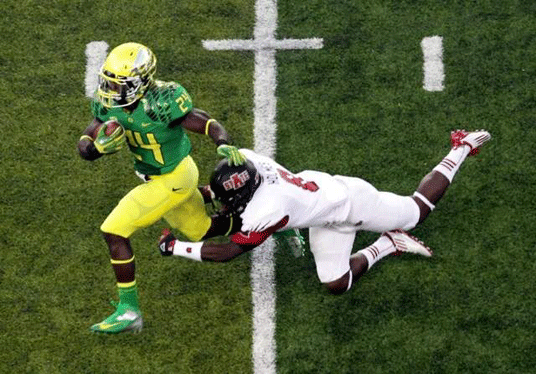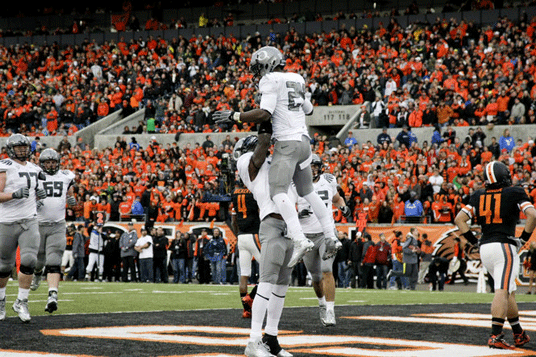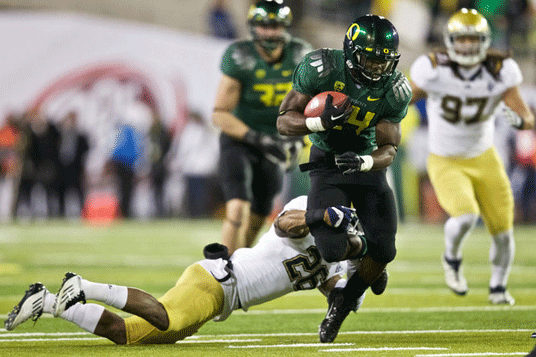 One week and 321 yards ago, Kenjon Barner was just another talented player in a nation full of talented players, waiting to show the country what most Duck fans already knew: that he is the most complete player in college football. Now, along with Kansas State QB Collin Klein, Barner is one of two players in the country certain to be in New York City on December 8th for the Heisman Trophy ceremony. While it is an honor for any player to be a finalist, the question is, what can Barner do to win the Heisman?
One week and 321 yards ago, Kenjon Barner was just another talented player in a nation full of talented players, waiting to show the country what most Duck fans already knew: that he is the most complete player in college football. Now, along with Kansas State QB Collin Klein, Barner is one of two players in the country certain to be in New York City on December 8th for the Heisman Trophy ceremony. While it is an honor for any player to be a finalist, the question is, what can Barner do to win the Heisman?
The website Heismanpundit.com, which conducts weekly straw polls of Heisman voters, and is considered one of the leading authorities on the weekly status of the topic, has published what has been labeled the “10 Heismandments“, or a list of “the rules that govern the Heisman” – the more Heismandments that apply to the candidate, the better his chances of winning. Barner checks all the boxes, Heismandment 8a seems the most specific to his chances of success:
“A running back who is NOT on a traditional power or a national championship contender usually must gain at least 2,000 yards…a back on a traditional power or national title contender, must gain at least 1,600 yards. In either case, the back must score at least 15 touchdowns.”
Barner already has 20 touchdowns, rendering that concern moot. Yet while Oregon qualifies as a national championship contender, it doesn’t fit the definition of a “traditional power” in the way much of the voting populace (read: East Coast bias) considers it.
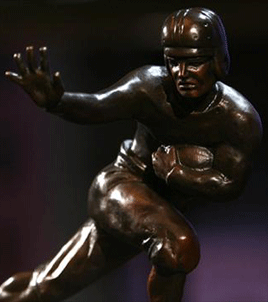 For a running back from a Pac-12 school it will be a challenge, but not impossible. Still, no non-USC, Pac-12 player has won the award since Stanford’s Jim Plunkett in 1970; although Stanford has had an astounding four second-place finishers (John Elway, Toby Gerhart, and Andrew Luck twice), the best anyone in the conference has finished in the four-plus decades since. Given those circumstances, it would appear it would take a remarkable season from a non-USC, Pac-12 player to win. 2,000 rushing yards in a season, something only done once in conference history (Cal’s J.J. Arrington in 2004) would qualify as that remarkable season.
For a running back from a Pac-12 school it will be a challenge, but not impossible. Still, no non-USC, Pac-12 player has won the award since Stanford’s Jim Plunkett in 1970; although Stanford has had an astounding four second-place finishers (John Elway, Toby Gerhart, and Andrew Luck twice), the best anyone in the conference has finished in the four-plus decades since. Given those circumstances, it would appear it would take a remarkable season from a non-USC, Pac-12 player to win. 2,000 rushing yards in a season, something only done once in conference history (Cal’s J.J. Arrington in 2004) would qualify as that remarkable season.
14 players in FBS history have rushed for over 2,000 yards in a single season. Of those 14, five won the Heisman trophy. Of the remaining nine that didn’t win:
- Three players (LaDainian Tomlinson, Kevin Smith, Matt Forte) did so for non-BCS programs.
- Five players (Troy Davis-twice, Byron Hanspard, Larry Johnson, Ray Rice, and Donald Brown) played on teams that finished fourth or lower in their conference.
- The lone remaining non-Trophy winning 2,000 yard rusher, the aforementioned J.J. Arrington, finished 8th in the voting despite an impressive resume – 2,018 yards and 15 TDs for a 10-win team. Unfortunately, he was likely no better than the fourth best player in his own conference (behind teammate Aaron Rodgers, who finished 9th and siphoned a large number of his votes, Reggie Bush – finished 5th, and Matt Leinart, who won the award), and simply picked a bad year to be a good player from the West Coast.
With a dearth of viable Heisman candidates from the West Coast outside of his own roster (Marqise Lee, a Sophomore WR on a 3-loss team seems his closest competition), Barner couldn’t have picked a better year to have a big season, and has a good chance to win the Heisman voting in the West region, and possibly the nation, provided he hits that signature milestone. So the big question remains:
What will it take for Kenjon Barner to reach 2,000 yards?
Barner currently has 1,295 yards through nine games – a fraction under 144 yards per game. Over a 12-game season, that projects to 1,727 yards, the third-best season in school history. That total would still be good enough to get him to New York, but missing the Pac-12 Championship would be a huge blow to his chances; both statistically, and to the credibility of playing for a national championship contender.
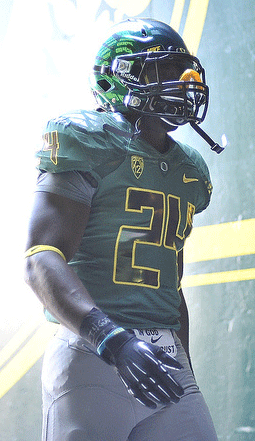 Should Oregon avoid a total disaster, his average would project to 1,871 yards in a 13-game season, making it the best mark in school history. Still, an extra 129 yards would be necessary to reach 2,000, meaning there are three important conditions to Barner getting there:
Should Oregon avoid a total disaster, his average would project to 1,871 yards in a 13-game season, making it the best mark in school history. Still, an extra 129 yards would be necessary to reach 2,000, meaning there are three important conditions to Barner getting there:
- He has to play in the conference championship
- Raise his current rushing average by more than 32 yards per game over the last four games
- And he has to do so while playing the conference’s top two rushing defenses in two of those games
Barner needs 705 yards over the final four games to reach that milestone, against defenses of varying capability. Getting to that 176.3 yards/game average will require an effort above the current rushing defense averages of all of Oregon’s remaining opponents, and doing so against a team like Stanford (allowing 55.6 rush yards/game) could prove more difficult than doing so against an opponent like California (165.2 rush yards/game).
*Light math warning*: To determine expectations for Barner’s progress towards 2,000 yards, we have to develop a factor to determine reasonable yardage totals for each remaining game.
Oregon’s last three remaining regular season opponents are locked in: California, Stanford, and Oregon State. The fourth would be the Pac-12 South champion: either UCLA, USC, or Arizona State. Since UCLA is in first place in the South, and has the best rushing defense in the division, we will project them into this hypothetical. We already have a working knowledge of the types of evisceration Barner is capable of against USC and Arizona State.
Projected rushing yardage allowed based on average rushing yardage allowed of remaining opponents: California (165.2) + Stanford (55.6) + Oregon State (91.8) + UCLA (153.2) = 465.8 yards
Yards needed to reach 2,000: 705
705/465.8 = 1.51
Namely, Barner has to gain rushing yards at just over one and a half times what Oregon’s upcoming opponents have been allowing. Let’s see if he can do it, game-by-game:
California Golden Bears
Rushing Defense Rank (Conference/Nationally):7th/71st
Total Defense Rank (Conference/Nationally): 9th/75th
Best Individual Rushing Performance Against, 2012: Bishop Sankey, Washington and Stepfan Taylor, Stanford – 189 yards
Yards Needed: 249 yards
Is it realistic for Barner to get 249 yards against the Bears? The biggest factor is how long Barner stays in the game. If Oregon separates itself early, like the 28-point favorites they are and have shown to be most of the season, Barner could get pulled early. If it is a game for four quarters, as the last two trips to Berkeley have been for the Ducks, a higher number is much more likely. Barner has had 195+ yards in all three complete games he has played this season (Fresno State, WSU, USC), so getting the necessary yards over four quarters shouldn’t be a problem. Oregon had 365 rushing yards against Cal last season, including 239 by LaMichael James in the three quarters before his elbow injury. That Cal defense, which allowed only 109 rush yards per game against its non-Oregon opponents, was much better than this year’s version.
Stanford Cardinal
Rushing Defense Rank (Conference/Nationally): 1st/1st
Total Defense Rank (Conference/Nationally): 1st/20th
Best Individual Rushing Performance Against, 2012: Bishop Sankey, 144 yards
Yards Needed: 85
If Barner is pulled early from the Cal game, this is where he can make up ground. He has rushed for at least 85 yards in every game with more than 13 carries, which he will likely get far more than against the Cardinal. Were he to get pulled early in this game, it would likely mean he had a lot more than 85 yards, which would be no small feat against the nation’s top rushing defense.
Oregon State Beavers
Rushing Defense Rank (Conference/Nationally): 2nd/5th
Total Defense Rank (Conference/Nationally): 4th/30th
Best Individual Rushing Performance Against, 2012: Ka’Deem Carey, Arizona, 115 yards
Yards Needed: 140
Doesn’t that sound like the exact number of yards he would have in this game? 24 rushes for 140 yards would be a very Civil War-like line.
Pac-12 Championship, against (presumably) UCLA
Rushing Defense Rank (Conference/Nationally): 5th/59th
Total Defense Rank (Conference/Nationally): 7th/64th
Best Individual Rushing Performance Against in 2012: C.J. Anderson, Cal, 151 yards
Yards Needed: 231
Getting 231 yards in the 13th game of the season might appear daunting, but LaMichael James had 219 yards against UCLA in the Pac-12 Championship last year. That game was never the contest this game could be. If this year’s game is closer, it could lead to more carries, and more yards, for Barner.
More likely, Oregon will play USC in the conference championship. While much has been made of UCLA jumping USC in the BCS rankings this week for the first time since 2001, a victory in their rivalry game next week would re-capture the division for the Trojans. UCLA may currently have one fewer loss than USC, but their loss to Cal is far worse than any loss the Trojans have.
Recapping: 249 (Cal) + 85 (Stan) + 140 (OSU) + 231 (Pac-12 CG) = 705 + 1295 (1st 9 games) = 2,000 yards.
It will be a challenge, but that mark is also attainable. Should Barner fall short in total yardage, it won’t mean the end of his chances to win the Trophy. No award has more nebulous criteria for winning than the Heisman, but we know winning matters. Every running back to win the award this century played on a national championship finalist. Take care of the games, and the trophies will come. If Kenjon Barner is lucky enough, maybe the Heisman won’t be the only trophy he brings home.
Related Articles:
Chip Kelly Update: Everything's Good Again ...
Chip Kelly Update: Wailing and Gnashing of Teeth
Shock and Awe -- The Oregon Ducks' Football Hangover Effect
Despite Lopsided Score, Georgia State "Never Stopped Believing"
Hope Springs Eternal for Ducks
Incompetent Pac-12 Officials: How Do You Miss ALL of THIS?
Nathan Roholt is a senior writer and managing editor emeritus for FishDuck. Follow him on Twitter @nathanroholt. Send questions/feedback/hatemail to nroholtfd@gmail.com.


